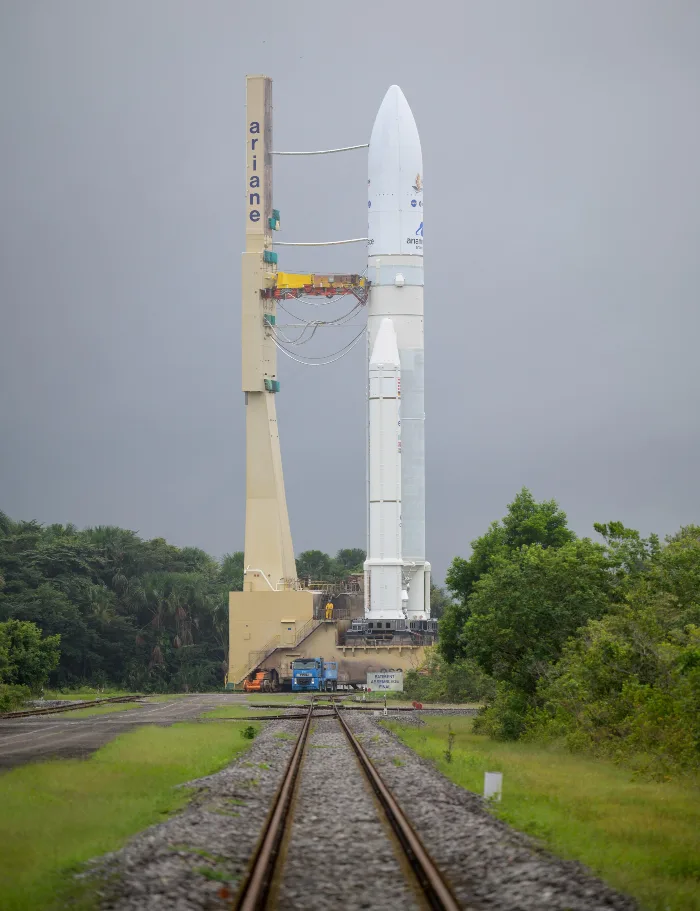The James Webb Space Telescope, the world's largest and most powerful space science telescope ever built, will be launched from Europe's Spaceport in Kourou, French Guiana, on the northeastern coast of South America at around 5.50 pm IST today.
NASA says that its newest premier space science observatory is destined to be a household name, like its predecessor Hubble, and will reveal new and unexpected discoveries, helping humanity understand the origins of the universe and its place in it.
"This is an Apollo moment for NASA science: Webb will fundamentally alter our understanding of the universe. It can observe all of the cosmos, from planets to stars to nebulae to galaxies and beyond – helping scientists uncover secrets of the distant universe as well as exoplanets closer to home," says the US space agency.
Webb is an international collaboration between NASA, the European Space Agency (ESA), and the Canadian Space Agency (CSA).
The large infrared telescope, with a 21.3 foot (6.5 metre) primary mirror – about three floors tall and as broad as a tennis court, a mirror this large has never before been put into space – will be launched on an ESA-provided Ariane 5 rocket.


Rockets launching from Guiana Space Centre benefit from a slingshot effect of being so close to the equator, where the rotational speed of Earth at the surface is greatest.
Once launched, it has a million-mile journey to reach its destination, where it can orbit the Sun in line with Earth.
Early birds
Night owls
Excited for the #NASAWebb launchFueling of the @Ariane5 rocket has begun ahead of a 7:20 AM ET (12:20 UTC) launch from Europe’s Spaceport in Kourou, French Guiana. Live coverage starts at 6 am ET (11:00 UTC). #UnfoldTheUniverse https://t.co/RyJmhSb3ML pic.twitter.com/hbBLhSIQlz
— NASA Webb Telescope (@NASAWebb) December 25, 2021
Routine science operations begin after about six months of commissioning, when all mirrors have been aligned and all instruments have been calibrated.
Fully operational, the state-of-the-art scientific instruments are engineered to produce a treasure trove of awe-inspiring imagery and data.
"Webb is designed to build upon the incredible legacies of the Hubble and Spitzer space telescopes, by observing the infrared universe and exploring every phase of cosmic history," says Eric Smith, NASA Webb's Programme scientist at the agency’s headquarters.
"The observatory will detect light from the first generation of galaxies that formed in the early universe after the big bang and study the atmospheres of nearby exoplanets for possible signs of habitability," he adds.

According to NASA, thousands of scientists, engineers, and technicians from 14 countries, 29 US states, and Washington DC, contributed to building, testing, and integrating Webb. Scientists from 41 countries and 42 US states have been awarded observing time during Webb's first year of science operations.
"We are opening the infrared treasure chest, and surprises are guaranteed. How did the universe make galaxies, stars, black holes, and planets, and our own very special little Earth? I don't know yet, but we are getting closer every day," says John Mather, Senior Project Scientist for the Webb mission.
Using the latest in augmented reality, or AR, NASA will be bringing the space exploring technologies of the telescope right into the homes of people all over the world.
NASA is also providing coverage of prelaunch, launch, and post launch activities for the James Webb Space Telescope on its social media platforms, including a livestream on its YouTube channel.
The launch would wrap up the busiest year of development ever for NASA when it successfully landed the Perseverance rover on the surface of Mars and piloted the Ingenuity Mars Helicopter – the first powered, controlled flight on another planet.
"Next year, NASA will accomplish more daring feats with new discoveries and technological advancements, especially as our Artemis I mission paves the way for future crewed missions to the Moon – and beyond," said NASA Administrator Bill Nelson.
Also Read: In a first, NASA’s Parker Solar Probe ‘touches’ the Sun in daring mission




















